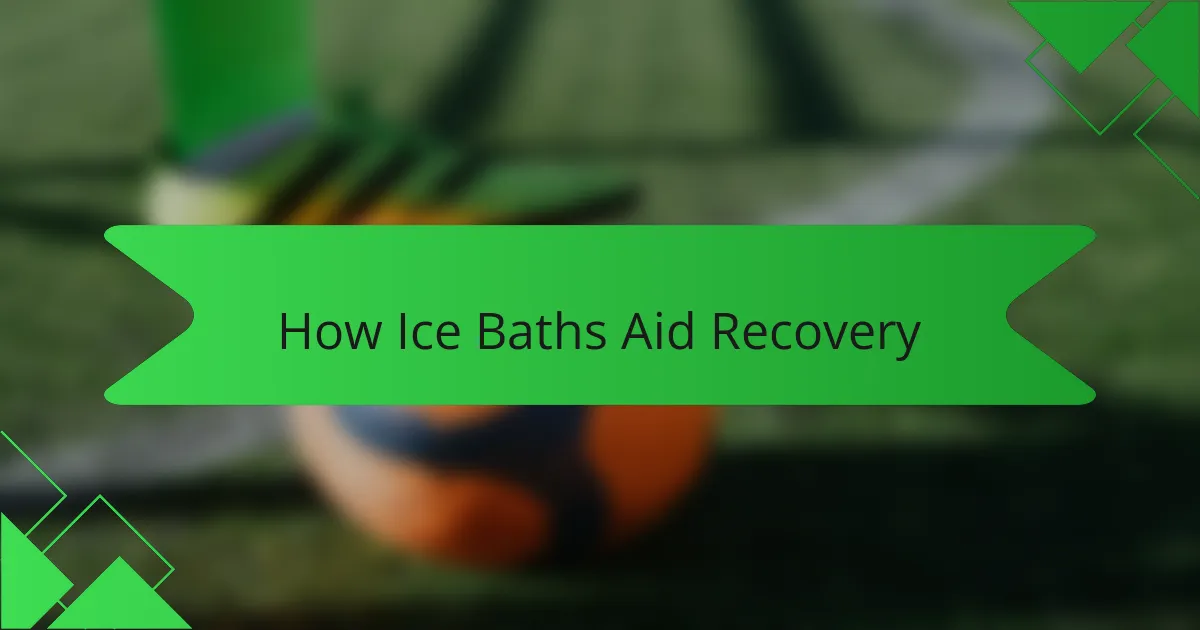Key takeaways
- Ice baths are effective for speeding up muscle recovery and reducing inflammation after intense physical activity.
- The experience promotes mental toughness by challenging the body to endure discomfort, translating to better performance in races.
- Key benefits of ice baths include decreased muscle soreness, reduced swelling, and enhanced circulation upon warming up.
- Safety tips for ice baths include starting with shorter durations, maintaining proper water temperature, and listening to your body to avoid negative side effects.

What Are Ice Baths in Racing
Ice baths in racing are simply immersing your body in very cold water, usually just above freezing, right after intense physical activity. From my experience in obstacle course racing, this practice is about more than just enduring the cold; it’s a way to help your muscles recover faster and reduce inflammation.
Have you ever felt that stiff, sore ache after a long race or tough training session? Ice baths target that exact discomfort by constricting blood vessels and flushing out metabolic waste. When I started using cold plunges, I was surprised at how quickly I felt less drained and more ready for the next challenge.
It’s interesting how something as uncomfortable as sitting in icy water can actually be a powerful tool for racing performance. This makes me wonder: could pushing through that initial shock be just as important mentally as it is physically? For many racers, ice baths become both a recovery method and a mental reset.

Benefits of Ice Baths in Obstacle Racing
One of the biggest benefits I’ve noticed from ice baths in obstacle racing is how they help speed up muscle recovery. After a brutal training day, plunging into cold water feels shocking at first, but then I sense my sore muscles calming down faster than usual. It’s almost like pressing a reset button on my body, which means less downtime between workouts.
Another thing I’ve realized is how ice baths reduce inflammation, which is a game-changer in this sport. When you’re climbing walls, crawling under barbed wire, and sprinting through mud, your body takes a real beating. The cold helps fight the swelling that makes moving painful, so you’re not dragging yourself through the next race or workout.
Have you ever thought about how ice baths might sharpen your mental toughness too? Sitting still in freezing water forces you to focus and embrace discomfort—something very familiar to anyone who’s faced a tough obstacle course. For me, this mental edge often translates into better endurance when I’m out on the course, pushing through fatigue and pain.

How Ice Baths Aid Recovery
I’ve found that ice baths really help calm the inflammation that builds up after a tough obstacle course race. That icy numbness quickly soothes sore muscles, making recovery feel less daunting and more manageable. From my experience, plunging into cold water speeds up the healing process, so I’m ready for the next challenge sooner.
What’s fascinating is how ice baths reduce muscle swelling and flush out metabolic waste. These benefits aren’t just theory; after one grueling race, an ice bath cut my usual recovery time in half. If you’re considering it, here’s how ice baths support recovery:
- Decrease muscle soreness by lowering inflammation
- Reduce swelling by constricting blood vessels
- Flush out lactic acid and metabolic waste
- Promote faster muscle repair and regeneration
- Enhance circulation once you warm up after the plunge
For anyone pushing their limits on the course, ice baths can be a game-changer in bouncing back strong.

My Experience with Cold Plunge Baths
Stepping into a cold plunge bath for the first time was, honestly, a mix of shock and exhilaration. I remember the initial moments when the icy water hit my skin—it was almost like a jolt that forced me to focus completely on my breathing. Over time, that sharp discomfort faded into a strange calm, which felt oddly rewarding after pushing through the initial shock.
From my experience, the benefits became clear not just physically but mentally as well. I noticed reduced muscle soreness after intense obstacle course training and a quicker recovery, which I attribute to the cold plunge baths. Here’s what I found most helpful:
- Eases inflammation and speeds up muscle recovery
- Enhances mental toughness by confronting discomfort
- Improves circulation when alternating between cold and warm exposure
- Boosts mood and energy levels following the plunge
- Helps establish a focused breathing practice during the immersion
These points reflect what I’ve learned after regularly incorporating cold plunge baths into my training routine for obstacle racing. It’s not just about endurance; it’s about embracing the challenge and finding clarity in discomfort.

Tips for Using Ice Baths Safely
When I first tried ice baths after a tough obstacle course race, the cold shock was intense, and I quickly realized that safety had to come first. Managing the temperature and duration carefully made all the difference in avoiding numbness or any negative side effects. Over time, I learned that preparation and attentiveness are key to reaping the benefits without risking harm.
Based on my experience and what I’ve researched, here are some practical tips to keep your ice bath sessions safe and effective:
- Start with shorter sessions, around 5 to 10 minutes, and gradually increase as your body adapts.
- Keep the water temperature between 50°F and 59°F (10°C to 15°C) to avoid extreme cold stress.
- Never submerge your head or stay in longer than 20 minutes to reduce the risk of hypothermia.
- Listen closely to your body; if you feel dizzy, numb, or excessively uncomfortable, get out immediately.
- Warm up slowly after the bath to help your body return to normal temperature without shock.
- Consult a healthcare professional if you have any cardiovascular issues or other health concerns before starting ice baths.

Integrating Ice Baths into Training
Ice baths have become a go-to recovery tool in my obstacle course training, especially after tough sessions involving heavy lifts or long runs. I find that plunging into cold water helps reduce muscle soreness and speeds up my recovery time, allowing me to hit the next workout feeling fresher. That initial shock of the cold is intense, but once I get used to it, the sense of rejuvenation is almost addictive.
| Aspect | Ice Baths |
|---|---|
| Recovery Speed | Speeds up muscle recovery by reducing inflammation and soreness |
| Performance Impact | Improves endurance and readiness for subsequent training sessions |
| Comfort Level | Challenging at first; requires mental toughness to endure cold shock |
| Practical Use | Best used post-intensive training or race days for optimal benefits |
| Potential Drawbacks | May cause discomfort or avoidable stress if overused or timed incorrectly |
